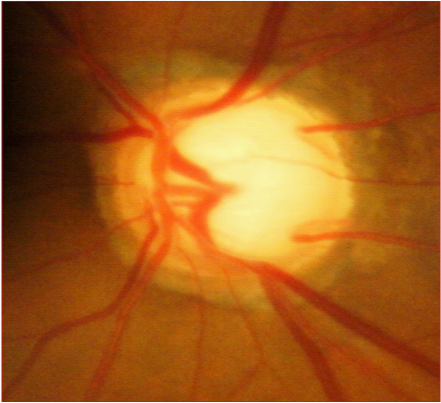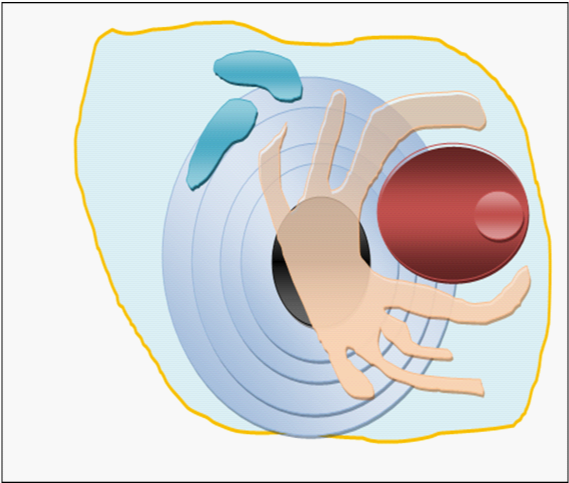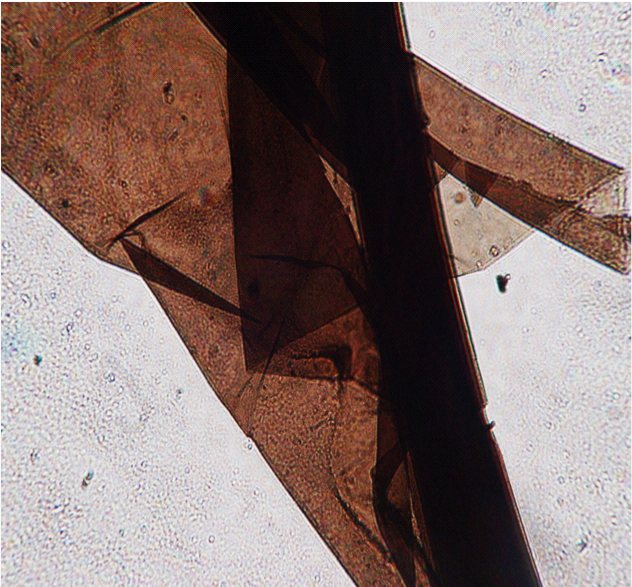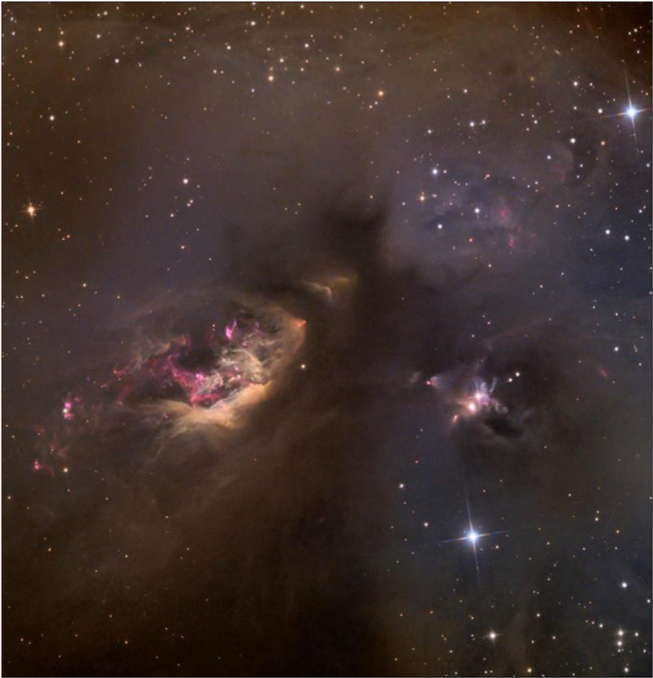MOJ
eISSN: 2374-6912


Review Article Volume 1 Issue 2
Human Photosynthesis Research Center, Mexico
Correspondence: Arturo Solis Herrera Human Photosynthesis Research Center, Lopez Velarde 108, Centro, Aguascalientes, Mexico, Tel 014499120261
Received: April 29, 2014 | Published: August 27, 2014
Citation: Herrera AS, Solis Arias PE. Einstein cosmological constant, the cell, and the intrinsic property of melanin to split and re-form the water molecule. MOJ Cell Sci Rep. 2014;1(2):46-51. DOI: 10.15406/mojcsr.2014.01.00011
The discovery of the intrinsic property of melanin to split and re-form the water molecule upended millenniums of scientific and religious wisdom. It is expected that most scientists refused to accept this theory for years, as has happened in the case of transcendent discoveries in the past, Copernicus, Galileo, and Magellan; for example.
Keywords: melanin, einstein cosmological constant, water dissociation, photosynthesis, energy
DHI, 5, 6-dihydroxyindole; IQ, indole 5, 6-quinone; SQ, semiquinone; DHICA, 5, 6-dihydroxyindole-2carboxilix acid; PAHs, polycyclic aromatic hydrocarbons; ISM, interstellar medium
Melanin is a ubiquitous biological pigment found in bacteria, fungi, plants, animals, and interstellar space. It has a diverse range of ecological and biochemical described functions, including display, evasion, photo-protection, detoxification, and metal scavenging. Melanin is found in fossils including, where is the best preserved compound. Its function within both eukaryotic and prokaryotic cells has been primarily relegated to the role of a simple built-in sunscreen.
Exceptional preservation of soft tissue is rare in the fossil record because microbial decomposition is highly efficient. Tissues that do survive are subject to diagenetic alteration whereby their organic constituents polymerize into long chains of hydrocarbons that are resistant to further degradation.1 Little original organic chemistry or ultra structure is typically retained in fossils more than 65Ma. Biomolecules that are polymeric and highly cross-linked in their original state exhibit the greatest resistance to alteration.
Melanin, a complex biopolymer, meets this high-resistance criterion. Among the biological roles described for melanin, we also have: photo-protection, radioprotection, display, camouflage, and predation avoidance,2 and some other functions, but given the extraordinary difficulty of studying the compound in situ and in the laboratory, no more could be advanced. Melanin has a wide range of unique chemical signatures that can be used to identify and characterize its different forms in nature.3 The single unique modern assay commonly used to identify melanin’s is alkaline hydrogen peroxide oxidation. Melanin breaks down into distinct chemical markers associated with its monomeric precursors DHI (5, 6-dihydroxyindole) together with their oxidized forms (Indole 5, 6-quinone (IQ))4 and semiquinone (SQ) and DHICA (5, 6-dihydroxyindole-2carboxilix acid). It is widely accepted that when these compounds are identified, known generically as quinone, we can say that it is melanin. Eumelanin is generated from these chemical building blocks, which are in turn derived from the amino acid tyrosine. These products are common only to Eumelanin and have never been produced by the alkaline hydrogen peroxide oxidation of any other biological material. Similarly, the unique markers for pheomelanin are TTCA and TDCA. The chemical degradation of the fossil pigments produces the expected markers for pheomelanin.
Photo-reactivity, ability to bind transition metal ions, redox properties and presence of persistent free radial centers in the pigment structure are usually mentioned as main features of eumelanins, although their biological significance is still unclear.5
Complex organic molecules –some like those found in living things-abound in dark parts of interstellar clouds.6 Infrared astronomy has also revealed that the interstellar medium contains a suite of complex gas-phase carbon compounds called polycyclic aromatic hydrocarbon, often abbreviated PAHs. These molecules, composed primarily of fused rings of carbon (either neutral or in an ionized state), are said to be the most common class of carbon compound in the galaxy (Figure 1).

Photo-dissociation takes place when the photon absorbed by the molecule has a sufficient energy to dissociate the molecule. The photon energy is distributed on all vibrational degrees of freedom of the molecule. Large molecules have more degrees of freedom available to store the excess energy brought by photons, which modify the photo-dissociation rate.
In Central Nervous System, neuro-melanin (Dopamine-quinone) is synthesized by oxidation of the catechol ring of dopamine. If this occurs within the neuronal cytosol, the quinone may react with cytosolic components, particularly with cysteine residues. In contrast, if quinone is produced within neuronal lysosomes it may provide the fundamental building block for neuro-melanin.7
In 1990, during a observational study about the three major causes of worldwide blindness (Macular degeneration age-related; Diabetic retinopathy; and glaucoma), whose working hypothesis was try to finding valid indicators of early disease in the blood vessels of the optic nerve, which are tiny because the optic nerve in human measures equivalent to twelve human hair together (Figure 2).

The study, which lasted twelve years and realized about six thousand patients, allowed us to detect the presence of melanin in the vicinity of the optic nerve in all patients studied, regardless of diagnosis. Which led us to wonder for nature wanted a simple built-in sunscreen in a structure that is almost a 3cm deep?
The functions described in the scientific literature about the melanin in the eye, did not give us the answer, and since the nature emphasis was obvious and nature only insist on really important things, we decided to delve in search of that.
During the twelve years tough study (1990-2002) were several questions that arose because the main variables studied were the morphological characteristics of the blood vessels and melanin; but that allowed detection of vascular endothelial cells that respond to the presence of melanin. This fact was not published but it did consist to us, thanks to the digital records of the optic nerve of patients.
And it was after a long search in the literature, and after some experimentation; we identified certain regularity in the interaction of melanin with the blood vessels, that is: the greater the amount of melanin equals fewer vessels and vice versa. And after analyzing the various peptides with activity on the vessels, the consistency of melanin/ blood vessels relationship led us deeper into the possible explanatory mechanism, because if was due to a compound such as a some kind of peptide (PEDF for example) the effect is not as consistently given biological variability both peptide itself as cell membrane receptors involved.
Therefore, we looked for a possible mechanism that does not depending of receptors or peptides; and after much searching, we were able to conclude that the best explanation for us was high molecular oxygen levels; due to it is considered the best known anti-angiogenic today (Figure 3).

And the levels of oxygen saturation are very high in the blood vessels, especially in veins, of the more pigmented eye tissue: choroid (Greek grape color). Thereby next step in our study, was try to find where it came from so much oxygen; as it was impossible that it came from the lungs.8
We review in detail the known biochemical reactions and processes described in the literature, and we could not find any molecule that would donate so much molecular oxygen and so consistently. So eventually discern that the only possibility left was that we were melanin dissociating water molecule.
And in literature began to find indirect evidence supporting our hypothesis9 In addition to our own experiments, and these eventually allowed us to obtain some patents (Figure 4 & 5).10
The dissociation of the water molecule occurs within the melanin can be written as follows:
2H2O ↔ 2H2 + O2 + 4e-
The process in melanin has significant differences in chlorophyll happen, namely:
(Chlorophyll) 2H2O → 2H2 + O2
Chlorophyll dissociation is irreversible, and the melanin is reversible, for every two molecules of water to be re-formed, four high-energy electrons are generated. In both cases, the main reaction product is molecular hydrogen, because it is the main carrier of energy in the entire universe; on the other hand oxygen toxic at any concentration. And in the case of melanin, the four high-energy electrons are very useful because they can be used as activation energy.
Actually, the cell uses energy in many ways; it has learned to do over four billion years of evolution. Besides that the best antioxidant that is known is the diatomic hydrogen (Figure 6).

Melanin releases energy symmetrically in all directions, in ways similar to increasing energy spheres that resemble the shape of melanin granules, so that could be considered fractals. The growing fields of energy that comes from melanin, are alternately nature therefore contain a higher concentration of diatomic hydrogen, which does not mix with water only moves through it, and other areas contain higher concentration of water re-formed, and therefore high energy electrons available.
Startup thinks that melanin accounted for 34% of the cell energetic, but as we went deeper into the investigation, we now think that represents a percentage higher than 90%. We have understood that glucose is not a source of energy, but biomass, as with glucose our body produces skin, nails, bone, muscle, ligaments, and all bio-molecules that require atoms or carbon chains in composition, e.g. genes.
But the energy, making the cell from water, like plants, or more strictly in the light, but must go through the water. Therefore, the molecular biology should be rearranged in the light of the unexpected intrinsic property of melanin to transform light energy into free chemical energy, and this occurs wherever the melanin is located either within the cell or in the space interstellar.
Melanin dissipates the energy absorbed by dissipating the water molecule, but also the modulation; this is even absorb huge amounts of energy, the flexibility of the process by which dissipates as it is reversible; allows melanin to act as a modulator, because although the power of the environment is too great, the power output of the melanin is maintained within a narrow range; and vice versa, that is: when the available power is limited, increasing the melanin. This happens within the cell and in interstellar space.
Accumulations of melanin in the edges of the optic disc is a common finding during the eye examination, but so far been considered embryonic remnants, and therefore had no relevance, nor clinical neither functional. But to continue the protocol, we realized that it was a fully wrong concept, because due to melanin intrinsic property of transforming light energy into chemical free energy through the dissociation of the water molecule, we eventually were able to understand that it is a molecule essential for life, because it is equivalent to nothing less than human chlorophyll.
Einstein was sure that the Universe was static, homogeneous model with spherical geometry; and so, in 1917, he introduced into his equations a cosmological constant (Λ) as a repulsive force required to keep the Universe in static equilibrium. The gravitational effect of matter caused acceleration in this model which Einstein did not want. Thus Einstein introduced a cosmological constant into his equations for General Relativity. This term acts to counteract the gravitational pull of matter, and so it has been described as an antigravity effect. But a source of repulsive gravity implies negative energy and dissipates any melanin that absorbs energy, including gravity through the dissociation of the water molecule, and could also be represented as 1 / G.
In the context of cosmology the cosmological constant is a homogeneous energy density that causes the expansion of the universe to accelerate. This concept was abandoned when the universe was found to be expanding. Now the cosmological constant is invoked to explain the observed acceleration of the expansion of the universe. The cosmological constant is the simplest realization of dark energy, which the more generic name is given to the unknown cause of the acceleration of the universe.
Einstein (1917) thought this: "The term is necessary only for the purpose of making possible a quasi-static distribution of matter, as required by the fact of the small velocities of the stars"
Einstein´s goal was to obtain a Universe that satisfied Mach’s principle of the relativity of inertia and construct a cosmology that was finite, yet stable against gravitational collapse, and the masses of galaxy-sized melanin definitely have to see. When Hubble observationally discovered the expansion of the universe Einstein finally abandoned the cosmological constant completely in 1931.
In the intervening years the cosmological constant came in and out of vogue as new observational results seemed to require it, but then was explained in other ways. Theoretical arguments from inflation and later observational results from cosmic microwave background radiation indicated the universe should be flat, but observations of large scale structure indicated that the matter density was inadequate to achieve this.
The High-Z supernova team and the supernova Cosmology project both discovered that high-redshift supernova were fainter than expected for a decelerating universe and that the difference could be explained if there was a cosmological constant of just the right magnitude needed to make the universe flat. Since then increasingly accurate probes have confirmed to high precision the need for dark energy or dark gravity. One of Einstein´s most significant discoveries was that the distribution of energy determines the geometry of space time, which is encoded in his field equation:
Rμν−1/2Rgμν=8πGTμν
Where G is the gravitational constant and cosmological constant what Einstein added in order to achieve a static universe, is given the symbol Λ:
Rμν−1/2Rgμν+Λgμν=8πGTμν
When Λ is positive it acts as repulsive force.
The cosmological constant (Λ) is not diluted as the universe expands, whereas the density of matter drops in inverse proportion to the volume. And this concept is difficult to explain, let alone understand; but the intrinsic property of melanin to dissipate the water molecule means a breakthrough in the understanding and knowledge of the phenomenon.
Dark energy is the name given to whatever is causing the expansion of the Universe to accelerate. One theory predicts that an unchanging entity pervading space called the cosmological constant is behind the dark energy. The unchanging entity may refer to melanin, the substance that is known more stable, and thus their physicochemical properties are also immutable.
All the planets, stars, galaxies, and gas that can be seen today make up just 4percent of the universe. The other 96% is made of stuff nobody can see, even with the most powerful telescopes. And melanin is the perfect candidate since all types of energy absorbed and emitted, not reflected, refracted no nothing; therefore it would be invisible to the telescope.
The study of rolling scalar fields, suggests that whatever’s causing dark energy isn’t a constant, but has changed through time. If that were true, though, it should have caused the values of other fundamental constants of nature to change too. Melanin can also explain the observed changes, since melanin is a molecule with a very particular dynamic, changing but within narrow ranges; but otherwise is not inert in any way.
The measurement of the ratio between the mass of the proton and mass of the electron shows that this constant has remained remarkably steady over time. The proton and the electron are two fundamental particles that make up the atoms inside stars, galaxies and people. And the energy that emanates from the melanin would be the energy that directs both within the cell and in the vast interstellar spaces.
Observation of alcohol molecules in a distant galaxy, found that the protons and electrons in those molecule’s atoms weigh about the same as the ones right here on Earth. Because the galaxy they studied lies 7billion light-years away, its light has taken that long (7billion years) to travel to Earth, and thus we are seeing it as it was half the universe’s lifetime ago. The observations strongly suggest that this fundamental constant has remained mostly unchanged over the past 7billion years.
The expected value of the Einstein cosmological constant, based on known physics, is a number more than 10 to the power of 60. Pressure has weight in general relativity.
The first detection of nonluminous matter from its gravitational effects occurred in 1844, when Friedrich Wilhelm Bessel announced that several decades of positional measurements of Sirius and Procyon implied that each was in orbit with an invisible companion of mass comparable to its own.11 If one accepts the evidence for nonluminous mass on many scales, the next obvious question is, what is it made of?
A single candidate would be the most elegant solution, but is asking a great deal of any one sort of thing that it be “cold” enough to settle down into the Milky Way disk and simultaneously “hot” enough to remain much less clustered than the super clusters over the age of the Universe. However, if melanin is able to act in two ways, as a single substance in nature that seems to have something like two specific heats, one high, when the temperature is high, and absorbs much letting out little or no, and when the temperature is low, the melanin is capable of acting as a substance with low specific heat; this is hardly absorbs and releases more heat than it receives.
And the intrinsic property of melanin to dissociate and re-form the water molecule can explain it properly, because it is the way that melanin absorbs the energy dissipates, so it meets the laws of thermodynamics; and any chemical reaction, the direction of the reaction depends on the concentration of the reactants, temperature, humidity; the amount of light on the characteristics of the surrounding environment, etc.. Therefore the reaction can go from right to left or left to right depending on the conditions present.
The dissociation of the water molecule within the melanin can be written as follows:12
2H2O ↔ 2H2 + O2 + 4e-
Melanin can absorb any type of energy, including mechanical, and also any wavelength. And dissipates in a unique way in nature, dissociating the water molecule, which is consistent since in the laboratory is necessary for reaction energetically expensive, to raise the water temperature of two thousand degrees Celsius. The main product of the reaction is the diatomic hydrogen, which is the quintessential carrier of energy in the entire universe.
On the other hand, oxygen is toxic at any concentration. But melanin far exceeds the capabilities of chlorophyll, for in it the water dissociation is irreversible, and melanin is reversible.
The perfect candidate for dark matter requires at least two characteristics: massive Nature and extraordinary stability and melanin possesses. For over 200years it is known that squid ink is melanin, and found in good condition on the bags of fossilized squid ink that died 170million years ago.13
The interstellar medium (ISM) is known to contain a variety of grains, including silicates, carbon rich particles and ices, and a large number of gas-phase species. The most abundant and widespread class of carbon carrying gaseous species is believed to be PAHs (Polycyclic Aromatic Hydrocarbons).14 In dense molecular clouds, where optical depths are high and the ambient radiation field of the galaxy is screened, temperatures are below 50K (-223.15°C). Under these conditions, most gas-phase species are quickly condensed onto the more refractory grains in the formed of mixed molecular ices. These ices contain a variety of molecular species, the most abundant of which is H2O. And water is the perfect substrate for melanin; and abounds both on Earth and in interstellar space.
Since the intrinsic property of melanin to dissociate and re-form the water molecule, the mechanism by which dissipates the energy absorbed was not known, it is necessary to rethink the current algorithms used to study the density of each species, such as: reactions between PAH cations and H or H2, Photo-ionization, Electronic recombination, etc.
But one thing we can be sure, to be the most stable melanin substance (millions of years) is known is that it is conceivable that the predominant chemical species (and are) in stellar space.
By other hand, the huge masses of melanin observed in space, while larger, more electromagnetic radiation are able to capture, something similar to the antennas (the bigger the antenna the better the reception). So here, on planet earth Kleiber's law explains.15
The energy that makes stars move slowly is not a random energy, is a process that seems to be very careful, as is true anywhere in the cosmos that is likely to be observed, nor is it an energy that depends on a particular source; so the fact that it is a form of conventional energy in the cosmos and is transduced, transformed by the dark matter that very probably is melanin, and if any molecule is consistent in structure activity relationship is melanin, anywhere that this will act the Likewise, absorbing any kind of energy and leads it to levels found within relatively narrow ranges.
If the energy is much then is reduced, if the energy is low, then is increased. Melanin is able to absorb any kind of energy and the force of gravity is not an exception, thus it’s absorbed and consequently dissipated through the dissociation of the water molecule.
In the case of the universe, the galaxy-sized mass that forms melanin produced a powerful but constant effect on the adjacent stellar bodies, and so great is the melanin mass that its effect on gravity is conceivable that negative or repulsive gravity can be generated. But it is not a whimsical effect, is a carefully produced Indeed, it modulated by the intrinsic property of melanin to dissociate the water molecule.
We have observed in our laboratory experiments, the melanin tends to approach energy sources and surround them. And the same is true of the dark masses seen in the cosmos (Figure 7-11).





Einstein was quite right in saying that the geometry of space-time dependent distribution of energy, and inside the cell is the same. Furthermore, the energy distribution is not completely at random, i.e. no energy is generated and produces its effects randomly; but there is something that modulates it in a very consistent way, through the entire observable universe, and it shows that melanin has to do, because in reality, the changes in energy or temperature we observe in stellar space could be even more abrupt if melanin was not present. The function of melanin tempering allows suigener is organization of the entire universe and thereby the cell.
And that stellar motion follows the same pattern throughout the observable universe all. If melanin is present throughout interstellar space, also exerts its modulating function of energy as in the cell and body happens, both in the distribution of the same as up and down regulation; wherever you are16 of Human Photosynthesis® Research Center.
None.
The author declares no conflict of interest.

©2014 Herrera, et al. This is an open access article distributed under the terms of the, which permits unrestricted use, distribution, and build upon your work non-commercially.